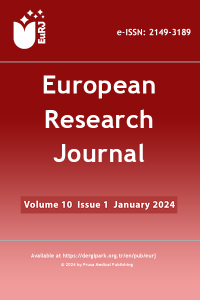Peritonitis in patients on peritoneal dialysis: a 12-year experience from a large medical center in Bursa
Abstract
Objectives: Despite all technical advances, Peritonitis remains the most important peritoneal dialysis (PD) complication. Peritonitis causes complications such as additional hospitalization, technical failure, peritoneal membrane damage, consequent transition to hemodialysis, and death in this patient group. Early diagnosis, isolation of the causative pathogen with appropriate methods as soon as possible, and determination of antibiotic susceptibilities play a crucial role in solving the problem of treating peritonitis in PD. This study evaluated the frequency of peritonitis, culture positivity rate, and prognosis in peritoneal dialysis patients in our unit for 12 years.
Methods: A total of 171 patients (80 F, 91 M; mean age: 51.9±15.3 year; mean PD duration 36.5±36.4 months) who were followed up in our department between January 2009 and July 2021 were included in the study. Patient records were retrospectively analyzed.
Results: Peritonitis never occurred in 105 of the 171 patients included in the study. Of the remaining 66 patients, 43 had one peritonitis attack, and 23 had more than two. The mean peritonitis rate was 1.68±1.36. One hundred eleven episodes of peritonitis were detected in 66 of the patients. Bacterial growth was observed in 63.06% of the culture samples obtained from the 93 peritonitis episodes. The peritoneal catheter was withdrawn in 14 (21.21%) cases.
Conclusion: In our unit, the rate of culture positivity was 63.06%, and the peritonitis attack rate was 0.017 per patient-month and 0.211 per patient-year over a period of twelve years, with a mean of 57.1 patient months of peritonitis.
Keywords
References
- 1. Bello AK, Okpechi IG, Osman MA, et al. Epidemiology of peritoneal dialysis outcomes. Nat Rev Nephrol. 2022;18(12):779-793. doi: 10.1038/s41581-022-00623-7.
- 2. Szeto CC, Li PK. Peritoneal dialysis-associated peritonitis. Clin J Am Soc Nephrol. 2019;14(7):1100-1105. doi: 10.2215/CJN.14631218.
- 3. Li PK, Szeto CC, Piraino B, et al. ISPD Peritonitis Recommendations: 2016 Update on Prevention and Treatment. Perit Dial Int. 2016;36(5):481-508. doi: 10.3747/pdi.2016.00078.
- 4. Seyahi N, Ateş K, Süleymanlar G. Current Status of Renal Replacement Therapy in Turkey: A Summary of the 2019 Turkish Society of Nephrology Registry Report. Turkish J Nephrol. 2021;30(2):105-111. doi: 10.5152/turkjnephrol.2021.21436
- 5. Şeker A, Candan F, Hüzmeli C, Akkaya L, Kayataş M. [Evaluation of continuous ambulatory peritoneal dialysis-related peritonitis attacks]. Turk Neph Dial Transpl 2016;25(2):142-146. doi: 10.5262/tndt.2016.1002.03. [Article in Turkish]
- 6. Öztürk Y, Delikanlı Çorakçı B, Bilici M, Boraza A. [In our unit, peritonitis incidence and agents determined during six-year period]. Batı Karadeniz Tıp Derg. 2017;1(2):46-51. [Article in Turkish]
- 7. Marshall MR. A systematic review of peritoneal dialysis-related peritonitis rates over time from national or regional population-based registries and databases. Perit Dial Int. 2022;42(1):39-47. doi: 10.1177/0896860821996096.
- 8. Ghali JR, Bannister KM, Brown FG, et al. Microbiology and outcomes of peritonitis in Australian peritoneal dialysis patients. Perit Dial Int. 2011;31(6):651-62. doi: 10.3747/pdi.2010.00131.
- 9. Mujais S. Microbiology and outcomes of peritonitis in North America. Kidney Int Suppl. 2006;(103):S55-62. doi: 10.1038/sj.ki.5001916.
- 10. Perl J, Fuller DS, Bieber BA, et al. Peritoneal dialysis-related infection rates and outcomes: results from the Peritoneal Dialysis Outcomes and Practice Patterns Study (PDOPPS). Am J Kidney Dis. 2020;76(1):42-53. doi: 10.1053/j.ajkd.2019.09.016.
- 11. de la Espada Piña V, Ganga PLQ, Junquero JMG, et al. Two decades of analysis of peritonitis in peritoneal dialysis in Andalusia: epidemiological, clinical, microbiological and progression aspects. Nefrologia (Engl Ed). 2021;41(4):417-425. doi: 10.1016/j.nefroe.2021.10.004.
- 12. Htay H, Cho Y, Pascoe EM, et al. Center effects and peritoneal dialysis peritonitis outcomes: analysis of a national registry. Am J Kidney Dis. 2018;71(6):814-821. doi: 10.1053/j.ajkd.2017.10.017.
Abstract
References
- 1. Bello AK, Okpechi IG, Osman MA, et al. Epidemiology of peritoneal dialysis outcomes. Nat Rev Nephrol. 2022;18(12):779-793. doi: 10.1038/s41581-022-00623-7.
- 2. Szeto CC, Li PK. Peritoneal dialysis-associated peritonitis. Clin J Am Soc Nephrol. 2019;14(7):1100-1105. doi: 10.2215/CJN.14631218.
- 3. Li PK, Szeto CC, Piraino B, et al. ISPD Peritonitis Recommendations: 2016 Update on Prevention and Treatment. Perit Dial Int. 2016;36(5):481-508. doi: 10.3747/pdi.2016.00078.
- 4. Seyahi N, Ateş K, Süleymanlar G. Current Status of Renal Replacement Therapy in Turkey: A Summary of the 2019 Turkish Society of Nephrology Registry Report. Turkish J Nephrol. 2021;30(2):105-111. doi: 10.5152/turkjnephrol.2021.21436
- 5. Şeker A, Candan F, Hüzmeli C, Akkaya L, Kayataş M. [Evaluation of continuous ambulatory peritoneal dialysis-related peritonitis attacks]. Turk Neph Dial Transpl 2016;25(2):142-146. doi: 10.5262/tndt.2016.1002.03. [Article in Turkish]
- 6. Öztürk Y, Delikanlı Çorakçı B, Bilici M, Boraza A. [In our unit, peritonitis incidence and agents determined during six-year period]. Batı Karadeniz Tıp Derg. 2017;1(2):46-51. [Article in Turkish]
- 7. Marshall MR. A systematic review of peritoneal dialysis-related peritonitis rates over time from national or regional population-based registries and databases. Perit Dial Int. 2022;42(1):39-47. doi: 10.1177/0896860821996096.
- 8. Ghali JR, Bannister KM, Brown FG, et al. Microbiology and outcomes of peritonitis in Australian peritoneal dialysis patients. Perit Dial Int. 2011;31(6):651-62. doi: 10.3747/pdi.2010.00131.
- 9. Mujais S. Microbiology and outcomes of peritonitis in North America. Kidney Int Suppl. 2006;(103):S55-62. doi: 10.1038/sj.ki.5001916.
- 10. Perl J, Fuller DS, Bieber BA, et al. Peritoneal dialysis-related infection rates and outcomes: results from the Peritoneal Dialysis Outcomes and Practice Patterns Study (PDOPPS). Am J Kidney Dis. 2020;76(1):42-53. doi: 10.1053/j.ajkd.2019.09.016.
- 11. de la Espada Piña V, Ganga PLQ, Junquero JMG, et al. Two decades of analysis of peritonitis in peritoneal dialysis in Andalusia: epidemiological, clinical, microbiological and progression aspects. Nefrologia (Engl Ed). 2021;41(4):417-425. doi: 10.1016/j.nefroe.2021.10.004.
- 12. Htay H, Cho Y, Pascoe EM, et al. Center effects and peritoneal dialysis peritonitis outcomes: analysis of a national registry. Am J Kidney Dis. 2018;71(6):814-821. doi: 10.1053/j.ajkd.2017.10.017.
Details
| Primary Language | English |
|---|---|
| Subjects | Nefroloji |
| Journal Section | Original Articles |
| Authors | |
| Early Pub Date | December 18, 2023 |
| Publication Date | January 4, 2024 |
| Submission Date | October 7, 2023 |
| Acceptance Date | November 14, 2023 |
| Published in Issue | Year 2024 Volume: 10 Issue: 1 - January 2024 |


